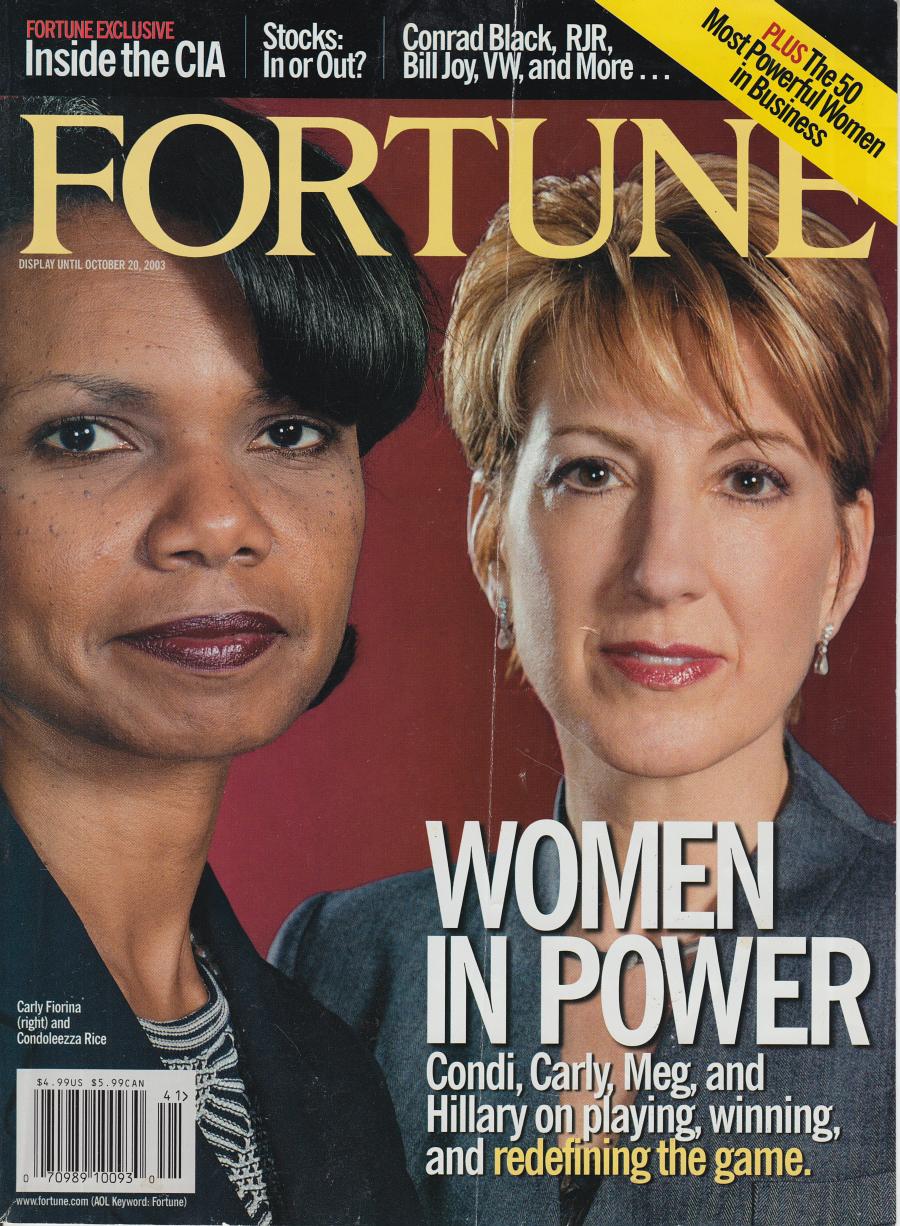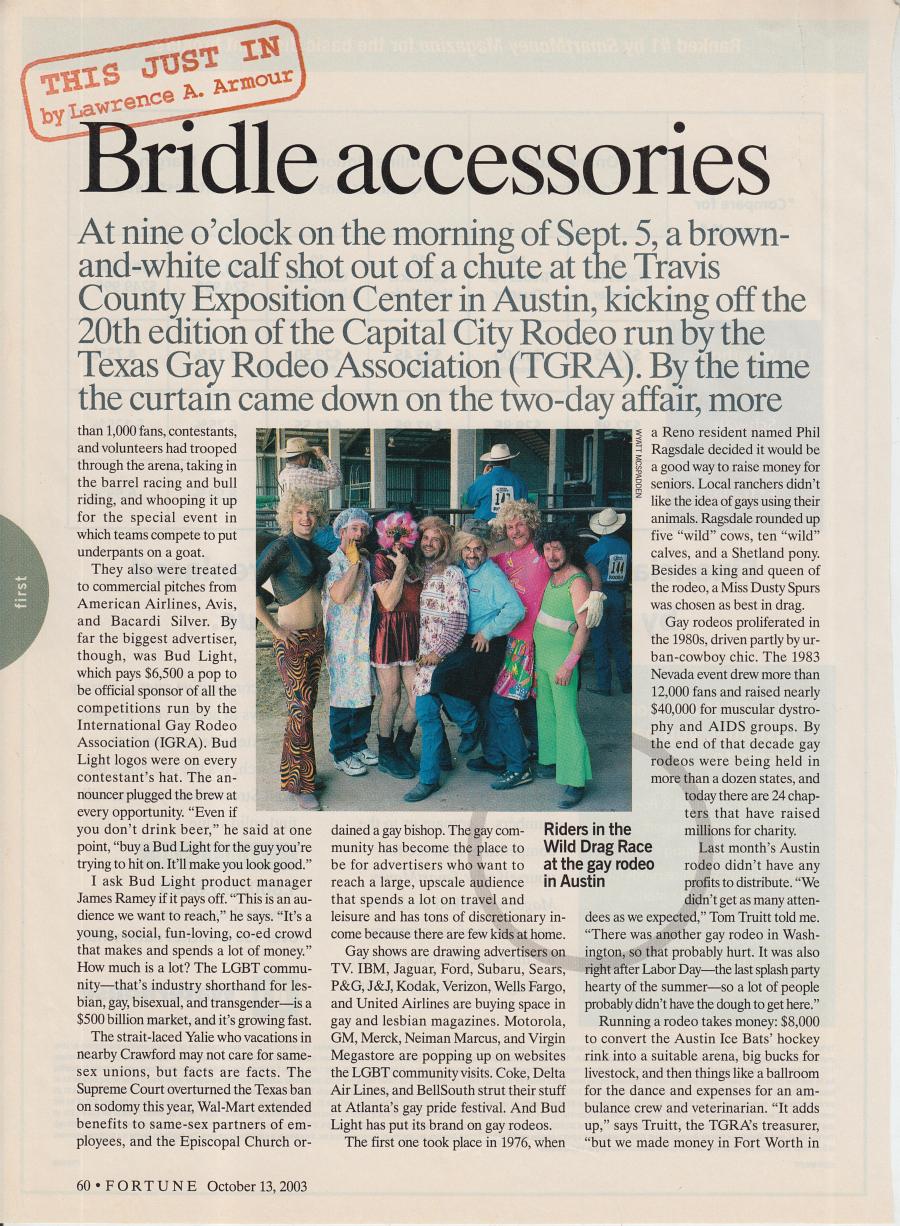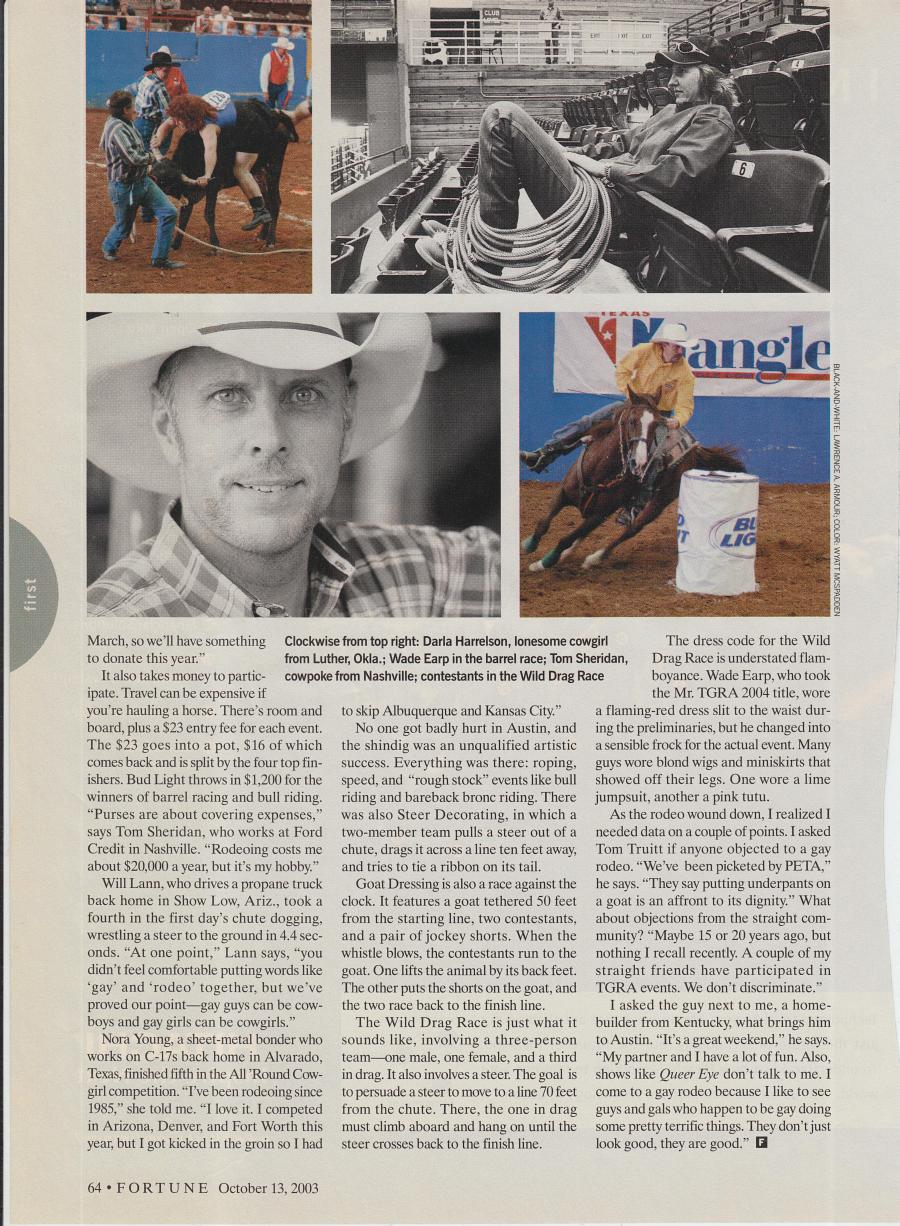


Bridle accessories
At nine o'clock on the morning of Sept. 5, a brown and white calf shot out of a chute at the Travis County Exposition Center in Austin, kicking off the 20th eaition of the Capital City Rodeo run by the Texas Gay Rodeo Association (TGRA). By the time the curtain came down on the two-day affair, more than 1,000 fans, contestants, and volunteers had trooped through the arena, taking in the barrel racing and bull riding, and whooping it up for the special event in which teams compete to put underpants on a goat.
They also were treated to commercial pitches from American Airlines, Avis, and Bacardi Silver. By far the biggest advertiser, though, was Bud Light, which pays $6,500 a pop to be official sponsor of all the competitions run by the International Gay Rodeo Association (IGRA). Bud Light logos were on every contestant's hat. The announcer plugged the brew at every opportunity. "Even if you don't drink beer," he said at one point, "buy a Bud Light for the guy you're trying to hit on. It'll make you look good."
I ask Bud Light product manager James Ramey if it pays off. "This is an audience we want to reach," he says. "It's a young, social, fun-loving, co-ed crowd that makes and spends a lot of money." How much is a lot? The LGBT community- that's industry shorthand for lesbian, gay, bisexual, and transgender-is a $500 billion market, and it's growing fast.
The strait-laced Yalie who vacations in nearby Crawford may not care for samesex unions, but facts are facts. The Supreme Court overturned the Texas ban on sodomy this year, Wal-Mart extended benefits to same-sex partners of employees, and the Episcopal Church ordained a gay bishop. The gay community has become the place to be for advertisers who want to reach a large, upscale audience that spends a lot on travel and leisure and has tons of discretionary income because there are few kids at home.
Gay shows are drawing advertisers on TV. IBM, Jaguar, Ford, Subaru, Sears, P&G, J&J, Kodak, Verizon, Wells Fargo, and United Airlines are buying space in gay and lesbian magazines. Motorola, GM, Merck, Neiman Marcus, and Virgin Megastore are popping up on websites the LGBT community visits. Coke, Delta Air Lines, and Bell South strut their stuff at Atlanta's gay pride festival. And Bud Light has put its brand on gay rodeos.
The first one took place in 1976, when a Reno resident named Phil Ragsdale decided it would be a good way to raise money for seniors. Local ranchers didn't z like the idea of gays using their animals. Ragsdale rounded up five "wild" cows, ten "wild" calves, and a Shetland pony. Besides a king and queen of the rodeo, a Miss Dusty Spurs was chosen as best in drag.
Gay rodeos proliferated in the 1980s, driven partly by urban-cowboy chic. The 1983 Nevada event drew more than 12,000 fans and raised nearly $40,000 for muscular dystrophy and AIDS groups. By the end of that decade gay rodeos were being held in more than a dozen states, and today there are 24 chapters that have raised millions for charity.
Last month's Austin rodeo didn't have any profits to distribute. "We didn't get as many attendees as we expected," Tom Truitt told me. "There was another gay rodeo in Washington, so that probably hurt. It was also right after Labor Day-the last splash party hearty of the summer-so a lot of people probably didn't have the dough to get here." Running a rodeo takes money: $8,000 to convert the Austin Ice Bats' hockey rink into a suitable arena, big bucks for livestock, and then things like a ballroom for the dance and expenses for an ambulance crew and veterinarian. "It adds up," says Truitt, the TGRA's treasurer, "but we made money in Fort Worth in March, so we'll have something to donate this year."
It also takes money to participate. Travel can be expensive if you're hauling a horse. There's room and board, plus a $23 entry fee for each event. The $23 goes into a pot, $16 of which comes back and is split by the four top finishers. Bud Light throws in $1,200 for the winners of barrel racing and bull riding. "Purses are about covering expenses," says Tom Sheridan, who works at Ford Credit in Nashville. "Rodeoing costs me about $20,000 a year, but it's my hobby."
Will Lann, who drives a propane truck back home in Show Low, Ariz., took a fourth in the first day's chute dogging, wrestling a steer to the ground in 4.4 seconds. "At one point," Lann says, "you didn't feel comfortable putting words like 'gay' and 'rodeo' together, but we've proved our point-gay guys can be cowboys and gay girls can be cowgirls."
Nora Young, a sheet-metal bonder who works on C-17s back home in Alvarado, Texas, finished fith in the All 'Round Cowgirl competition. "I've been rodeoing since 1985," she told me. "I love it. I competed in Arizona, Denver, and Fort Worth this year, but I got kicked in the groin so I had to skip Albuquerque and Kansas City."
No one got badly hurt in Austin, and the shindig was an unqualified artistic success. Everything was there: roping, speed, and "rough stock" events like bull riding and bareback bronc riding. There was also Steer Decorating, in which a two-member team pulls a steer out of a chute, drags it across a line ten feet away, and tries to tie a ribbon on its tail.
Goat Dressing is also a race against the clock. It features a goat teathered 50 feet from the starting line, two contestants, and a pair of jockey shorts. When the whistle blows, the contestants run to the goat. One lifts the animal by its back feet. The other puts the shorts on the goat, and the two race back to the finish line.
The Wild Drag Race is just what it sounds like, involving a three-person team-one male, one female, and a third in drag. It also involves a steer. The goal is to persuade a steer to move to a line 70 feet from the chute. There, the one in drag must climb aboard and hang on until the steer crosses back to the finish line.
The dress code for the Wild Drag Race is understated flamboyance. Wade Earp, who took the Mr. TGRA 2004 title, wore a flaming-red dress slit to the waist during the preliminaries, but he changed into a sensible frock for the actual event. Many guys wore blond wigs and miniskirts that showed off their legs. One wore a lime jumpsuit, another a pink tutu.
As the rodeo wound down, I realized I needed data on a couple of points. I asked Tom Truitt if anyone objected to a gay rodeo. "We've been picketed by PETA," he says. "They say putting underpants on a goat is an affront to its dignity." What about objections from the straight community? "Maybe 15 or 20 years ago, but nothing I recall recently. A couple of my straight friends have participated in TGRA events. We don't discriminate."
I asked the guy next to me, a home-builder from Kentucky, what brings him to Austin. "It's a great weekend," he says. "My partner and I have a lot of fun. Also, shows like Queer Eye don't talk to me. I come to a gay rodeo because I like to see guys and gals who happen to be gay doing some pretty terrific things. They don't just look good, they are good."